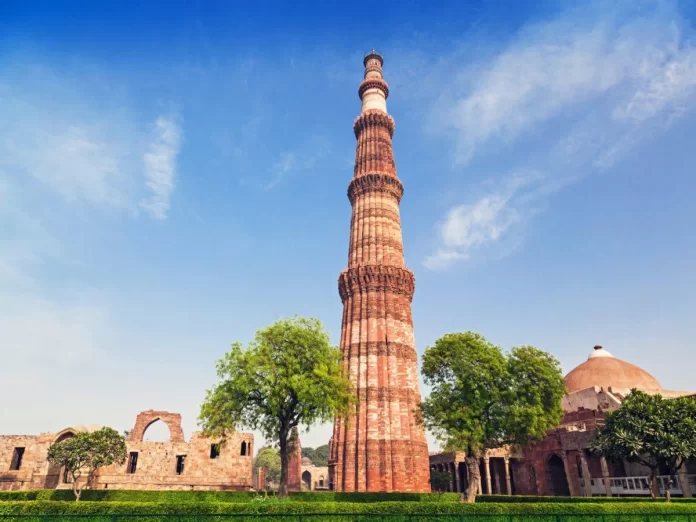Qutub Minar is the world’s tallest brick tower, located in the Mehrauli part of South Delhi city in India. It is a famous tourist spot in Delhi. It has a height of 72.5 m (237.86 ft) and a diameter of 14.3 m, rising to 2.75 m (9.02 ft) at the summit. It has 379 steps. The courtyard around the minaret has many exquisite specimens of Indian art, many of which date back to 1192. This complex has been approved by UNESCO as a World Heritage Site.
Inspired by the Minar of Jam, located in Afghanistan and wanting to overtake it, Qutbuddin Aibak, the first Muslim ruler of Delhi, got it started in 1193, but only got its foundation built. His successor Iltutmish increased it by three storeys and in 1368 Firoz Shah Tughlaq built the fifth and final storey. The minaret is made of red sandstone, on which finely carved verses of Quran and flowers of vines have been done.
Qutub Minar is the tallest minaret in India made of red and buff sandstone.
Built in the 13th century, this majestic tower stands in the capital, Delhi. Its diameter is 14.32 m at the base and about 2.75 m near the top at a height of 72.5 m.
There are other important monuments in this complex such as a gate built in 1310, Alai Darwaza, Quwat-ul-Islam Mosque; Tombs of Altmish, Alauddin Khilji and Imam Jamin; Alai Minar, seven meters high iron pillar etc.
Qutubuddin Aibak of the Ghulam dynasty. In D. 1199 the foundation of the minaret was laid and it was built to call for prayers and its first storey was built, after which three more storeys were built by his successor and son-in-law Shams Uddin Itutmish (A.D. 1211-36) Pair on this. All its floors are flanked by elevating balconies that encircle the minaret and are supported by stone brackets, which have a beehive-like decoration and this decoration is more pronounced on the first floor.
The Quwat-ul-Islam mosque is located to the north-east of the minaret, which was built by Qutbuddin Aibak during AD 1198. It is the oldest demolished mosque built by the Sultans of Delhi. It has an oblong courtyard surrounded by a raised shape on carved pillars and is an architectural member of the 27 Hindu and Jain temples that were destroyed by Qutbuddin Aibak, details of which are found in inscriptions excavated at the main eastern entrance. Later on a large semi-circular veil was erected and the mosque was enlarged. This work was done by Shams-ud-din Itutmish (AD 1210-35) and by Ala-ud-din Khilji.
The tomb of Itutmish (1211-36 A.D.) was built in A.D. 1235. It is a simple square chamber made of red sandstone, with many inscriptions, geometric figures and Arabic pai. Some of these examples are: wheels, fringes etc.
The Alai Darwaza, the south gate of the Quwat-ul-Ismal Mosque was built by Ala-ud-din Khilji in AH 710 (AD 1311), as recorded in the inscriptions carved on it. It is the first building to apply Islamic principles of construction and decoration.
The Alai Minar, which stands to the north of Qutub Minar, was commissioned by Ala Uddin Khilji with the intention of making it twice the size of Qutub Minar. He could only complete the first floor, which is now 25 meters high. Other remains of this complex of Qutb are madrasas, graveyards, tombs, mosques and architectural members.
UNESCO has declared this tallest stone tower in India as a world heritage.




